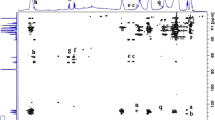Abstract
Fatty acid-binding proteins (FABPs) are a family of proteins that modulate the transfer of various fatty acids in the cytosol and constitute a significant portion in many energy-consuming cells. The ligand binding properties and specific functions of a particular type of FABP seem to be diverse and depend on the respective binding cavity as well as the cell type from which this protein is derived. Previously, a novel FABP (lcFABP; lc: Luciola cerata) was identified in the light organ of Taiwanese fireflies. The lcFABP was proved to possess fatty acids binding capabilities, especially for fatty acids of length C14–C18. However, the structural details are unknown, and the structure–function relationship has remained to be further investigated. In this study, we finished the 1H, 15N and 13C chemical shift assignments of 15N/13C-enriched lcFABP by solution NMR spectroscopy. In addition, the secondary structure distribution was revealed based on the backbone N, H, Cα, Hα, C and side chain Cβ assignments. These results can provide the basis for further structural exploration of lcFABP.


Similar content being viewed by others
References
Barber VC, Pilcher CW (1965) An enzyme histochemical and electron microscopical study of the light organ of the glow-worm, Lampyris noctiluca. Q J Microsc Sci 106:247–259
Buck J, Case J (2002) Physiological links in firefly flash code evolution. J Insect Behav 15:51–68. doi:10.1023/a:1014480028731
Cheng L, Jin XK, Li WW, Li S, Guo XN, Wang J, Gong YN, He L, Wang Q (2013) Fatty acid binding proteins FABP9 and FABP10 participate in antibacterial responses in Chinese mitten crab, Eriocheir sinensis. PLoS One 8:e54053. doi:10.1371/journal.pone.0054053
Delaglio F, Grzesiek S, Vuister GW, Zhu G, Pfeifer J, Bax A (1995) NMRPipe: a multidimensional spectral processing system based on UNIX pipes. J Biomol NMR 6:277–293
Esteves A, Ehrlich R (2006) Invertebrate intracellular fatty acid binding proteins. Comp Biochem Physiol C: Toxicol Pharmacol 142:262–274. doi:10.1016/j.cbpc.2005.11.006
Furuhashi M, Hotamisligil GS (2008) Fatty acid-binding proteins: role in metabolic diseases and potential as drug targets. Nat Rev Drug Discov 7:489–503. doi:10.1038/nrd2589
Gerstner JR, Vanderheyden WM, Shaw PJ, Landry CF, Yin JC (2011a) Cytoplasmic to nuclear localization of fatty-acid binding protein correlates with specific forms of long-term memory in Drosophila. Commun Integr Biol 4:623–626. doi:10.4161/cib.4.5.16927
Gerstner JR, Vanderheyden WM, Shaw PJ, Landry CF, Yin JC (2011b) Fatty-acid binding proteins modulate sleep and enhance long-term memory consolidation in Drosophila. PLoS ONE 6:e15890. doi:10.1371/journal.pone.0015890
Goh KS, Li CW (2011) A photocytes-associated fatty acid-binding protein from the light organ of adult Taiwanese firefly, Luciola cerata. PLoS One 6:e29576. doi:10.1371/journal.pone.0029576
Inouye S (2010) Firefly luciferase: an adenylate-forming enzyme for multicatalytic functions. Cell Mol Life Sci 67:387–404. doi:10.1007/s00018-009-0170-8
Lassen D, Lucke C, Kveder M, Mesgarzadeh A, Schmidt JM, Specht B, Lezius A, Spener F, Ruterjans H (1995) Three-dimensional structure of bovine heart fatty-acid-binding protein with bound palmitic acid, determined by multidimensional NMR spectroscopy. Eur J Biochem 230:266–280
Lopez-Castilla A, de Menezes RS, D’Andrea ED, Dos Santos TR, Pires JR (2015) (1)H, (15)N and (13)C resonance assignments and secondary structure prediction of Q4D059, a conserved and kinetoplastid-specific hypothetical protein from Trypanosoma cruzi. Biomol NMR Assign 9:161–163. doi:10.1007/s12104-014-9565-z
Lucke C, Rademacher M, Zimmerman AW, van Moerkerk HT, Veerkamp JH, Ruterjans H (2001) Spin-system heterogeneities indicate a selected-fit mechanism in fatty acid binding to heart-type fatty acid-binding protein (H-FABP). Biochem J 354:259–266
Lücke C, Gutiérrez-González LH, Hamilton JA (2004) Intracellular lipid binding proteins: evolution, structure, and ligand binding, cellular proteins and their fatty acids in health and disease. Wiley-VCH Verlag GmbH & Co. KGaA, pp 95–118
Ockner RK, Manning JA, Poppenhausen RB, Ho WK (1972) A binding protein for fatty acids in cytosol of intestinal mucosa, liver, myocardium, and other tissues. Science 177:56–58
Shen Y, Delaglio F, Cornilescu G, Bax A (2009) TALOS+: a hybrid method for predicting protein backbone torsion angles from NMR chemical shifts. J Biomol NMR 44:213–223. doi:10.1007/s10858-009-9333-z
Tan SJ, Zhang X, Jin XK, Li WW, Li JY, Wang Q (2015) Fatty acid binding protein FABP3 from Chinese mitten crab Eriocheir sinensis participates in antimicrobial responses. Fish Shellfish Immunol 43:264–274. doi:10.1016/j.fsi.2014.12.034
Wüthrich K, Billeter M, Braun W (1984) Polypeptide secondary structure determination by nuclear magnetic resonance observation of short proton–proton distances. J Mol Biol 180:715–740
Acknowledgments
This work is supported by a grant from the Ministry of Science and Technology (MOST), Taiwan (103-2627-B-007-001). We acknowledge the NMR facility at National Tsing Hua University supported by MOST.
Author information
Authors and Affiliations
Corresponding author
Ethics declarations
Ethical standards
The authors declare that the experiments comply with the current laws of Taiwan.
Conflict of interest
The authors declare that they have no conflict of interest.
Rights and permissions
About this article
Cite this article
Tseng, KL., Lee, YZ., Chen, YR. et al. 1H, 15N and 13C resonance assignments of light organ-associated fatty acid-binding protein of Taiwanese fireflies. Biomol NMR Assign 10, 71–74 (2016). https://doi.org/10.1007/s12104-015-9640-0
Received:
Accepted:
Published:
Issue Date:
DOI: https://doi.org/10.1007/s12104-015-9640-0




